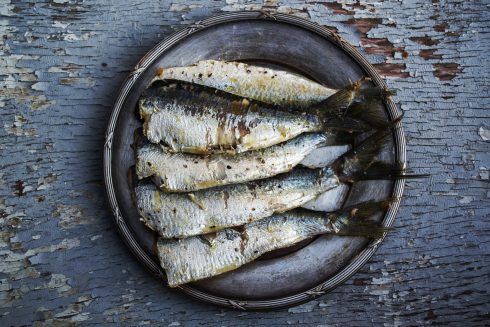WITHOUT a doubt one of Spain’s genuine world-leading gourmet delights is Cerdo Iberico – the pork from the black Iberian Pig.
What makes this meat so incredibly special is that for the last few months of each pig’s life, they are allowed to graze free-range in dehesas (acorn forests), munching their way through literally tons of bellotas (acorns), which have fallen from both holm and cork oak trees.
It is these acorns which gives the fat of the pigs its unique, sweet flavour, whether you are eating the ham or cooked pork.
Take a look at the pork in its raw state and you will notice how the meat is shot through with streaks of creamy white fat.
Best of all, this fat dissolves during the cooking process, flavouring the meat and making it perfectly tender.
The happy Iberican pig can only be bred in a few parts of the Spain and nowhere else in the world does it get its unique flavour.
In Spain this region stretches from as far south as the Aracena region, around Jabugo – the jamon capital of Spain – and then up into the far north of the Salamanca region.
With oak forests becoming increasingly endangered and shrinking each year, it is a finite production becoming more in demand each year, particularly since the US finally allowed its import in 2007.
Now priced at around 96 dollars a pound, these hams are often described as “the most expensive” in the world.
The acorns are the key to the quality of the meat, not just in the way they sweeten the fat.
The acorns make the pigs thirsty, forcing them to run around looking for water and making them more athletic, developing fine bones which are evident in a leg of jamon Iberico.
When I first came to live in Spain, my Spanish friends would tut, tut when I pulled the fat off a slice of ham (also refered to as Pata Negra because of the pigs’ black hooves) and cast it aside.
Most Spanish regard this fat as a delicacy and I now tend to agree. Its sweetness literally melts in your mouth. Wrapped around a tiny break stick (pico), followed by a sip of Fino sherry, it is simply divine.
Breeding these pigs is no cheap task – it is literally at the opposite end of the spectrum of normal intensive pig farming. This is obviously reflected in the price.
The most expensive and best quality is called jamon iberico de bellota (acorn).
This ham comes from pigs, who have lived free-range all their lives, dining almost entirely on acorns. The more exercise these pigs get, the more the fat blends into their muscles and the tastier the meat becomes. It is considered that 5J (cinco jotas), is the King of jamon bellota.
The next grade is called jamón ibérico de recebo. This ham is from pigs that are both pasture and compound fed a combination of acorns and grain.
The third type is called jamon iberico de pienso, or simply, jamon iberico. This ham is from Iberian pigs that are solely compound fed on grain and some acorns.
The term pata negra is also used to refer to jamon iberico in general and may refer to any one of the above three types.
It is important to note that jamón serrano comes from Cerdo Blanco (the more common white pigs) that is solely grain fed.
This comprises around 90 per cent of the pork and ham production in Spain. This is the cheapest of the jamons. It’s still delicious and perfect for sandwiches or cooking should your recipe call for jamon.
Another important thing to understand – in terms of price and quality – is which leg you are buying. A jamon iberico is normally the hind leg of the pig. A paletilla is the front leg.
Nevertheless, a paletilla can have an excellent taste and undergoes the same processes of ham-making. The difference is that a paletilla is smaller and has more fat. Therefore it’s cheaper.
So if you’re considering buying a ham, but can’t afford a Jamon Ibérico de Bellota, ask for a Paletilla Iberico de Bellota, it is usually less than half the price.
But my job is to give you some cooking ideas, so here is an idea for a good marinade to work with the pork. When correctly administered marinades can bring out flavours – wrongly administered and they can kill them all.
The acorns make the pigs thirsty, forcing them to run around looking for water and making them more athletic, developing fine bones which are evident in a leg of jamon Iberico.
Fennel seeds and pork are an Italian marriage, for example. Italian salami is often spiked with fennel seeds. It’s said that Roman Legionaries would chew on fennel seeds as they marched to suppress the pangs of hunger.
I have tried this. I have even tried being massaged using pure fennel seed oil – it doesn’t work… I like to cook mostly with what is known as presa Iberico.
Presa is the muscle between the top of the shoulder and the beginning of the loin. It can be found in most supermarkets pre-packaged and sliced.
If you go to your butcher – don’t be put off when you see a lump of pork, looking rather fatty. Remember it’s the fat that makes it special.
As it cooks, the fat will caramelize and intensify the sweetness.
Tell your butcher it’s for the BBQ or a la plancha. He should slice it like one normally slices smoked salmon. Another cut on offer, the secreto, is much cheaper but I find it a bit gristly and too fatty.
Some people far prefer this cut because of the tasty fat content. These are the people you can sell your fat to while ripping it off a slice of jamon iberico!
Finally, it should be noted this type of saturated animal fat is actually good for you as not only is it the best quality fat; it also leaves you feeling more satisfied. Animal fats give us energy and boost the immune system and can actually lower bad cholesterol.
Annie Manson
Check out the latest happenings at Annie B’s Spanish Kitchen
www.anniebs.co.uk or read my blog at http://anniebsspanishkitchen.blogspot.com









This lady realy knows her stuff. I LOVE Iberico Ham
Great article, but where is the marinade recipe?
Thanks for a very informative article which will hold me in good stead for my impending trip to Spain. I agree with the comment above and would like to see the recipe. But can it really be good for lowering cholesterol? Very interesting.
Pimpernel
Now this what Spanish Jamon is all about. Mind you the whole Jamon culture has thrown up so many misconceptions it could be called a facticious religion!
I’ve a few friends in the wifes village in Extremadura who feed their own pigs to take carry out the “Matanza” (literally massacre) in December each year and their observations drove me to write the following which I believe compliments the above article: http://www.uniquespain.com/spanish-ham.html
1. We dont use dollars we have euros.
2. We dont use pounds we have kilos.
3. Saturated fat is not good for you in excess, it may taste nice but it is not healthy. Animal fats are almost entirely saturated fats and will not lower “bad” LDL cholesterol.
Strange comments Ben. Dollars and pounds came after a line which mentions access to the US market for the first time, so not exactly out of context.
Since when is saturated fat not good for you? What about all those fat soluble vitamins? In excess it might be, but then anything consumed in excess is probably bad for you. Despite the popular dogma, nobody has yet been able to prove that saturated fat causes the diseases it’s often blamed for. The French paradox is good example of where the opposite may be true. The causes for the diseases blamed on saturated fat are a lot more complex.
Ibérico de Bellota ham is a natural food, rich in protein, vitamin B1, iron, zinc and magnesium.
The quality of the fat contained in Ibérico ham is excellent, consisting primarily of unsaturated fatty acids, and in particular, monosaturate oleic acid, representing over 50% of the fat content. (Olive oil contains 55%-83% oleic acid) Think acorn oil… not saturated FAT… The major fatty acids oleic (48,25%), linoleic (35,61%), and palmitic acids (11,22%) respectively. Lower levels in stearic (1,49%) and Œ±-linolenic acids (0,74%) were quantified. Total percentage of the mono-unsaturated fatty acids was 49,19%. Poly-unsaturated (36,38%) and saturated fatty acids (14,05%) showed relatively lower concentrations. Total unsaturated fatty acids observed at very high level (85,57%). The ratio of unsaturated fatty acids to saturated ones was also relatively high (6:1).
The fruit of both the holm oak and cork tree, are the basis of the Ibérico pig’s diet, although it also feeds on the pastures, stubble and wild leguminous, making a decisive contribution to the ecological balance of it’s natural habitat.
Hello
I would like to purchase Spanish Or Portuguese Black Pork but cannot find any supplier in the UK. Do you know if any butchers in Spain will take small domestic orders and send by courier to UK?
G D McIlvain
Careful there, Cerdo Iberico has nada to do with the excellent Pata Negra or Blackfoot Pigs but rather describes all pork from the Iberian Peninsular ………
here is a link for more info as well as a supplier
http://www.jrnet.com/jrnet/index.php?option=com_content&task=view&id=14
Que aproveche
One of the cheapest cuts of Black Pork is the shoulder. Quickly seared on the BBQ and then cooked indirect on the BBQ for approximately one and half hours it is magnificient!!!
Where do you suggest I buy a good quality shoulder of ham? (a leg is too much) In the area around Fuengirola ?
The 2 specialist shops I have used in past years have closed down.